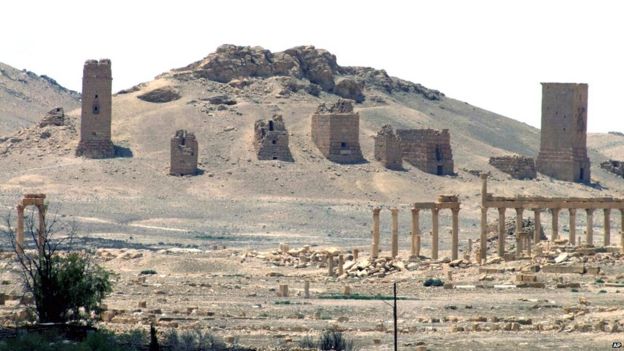Palmyra's Baalshamin temple 'blown up by IS'
By BBC News
Islamic State militants have destroyed Palmyra's ancient Temple of Baalshamin, Syrian officials and activists say.
Syria's head of antiquities was quoted as saying the temple was blown up on Sunday. The UK -based Syrian Observatory for Human Rights (SOHR) reported that it happened a month ago.IS took control of Palmyra in May, sparking fears for the site.
It is considered one of the ancient world's most important cultural centres.
The ancient city, which is a Unesco World Heritage site, is famed for its well-preserved Greco-Roman ruins, and the Baalshamin temple, built nearly 2,000 years ago, is one of the city's best-known buildings.
The Islamic State group has destroyed several ancient sites in Iraq. The militants believe any shrines or statues implying the existence of another deity are sacrilege and idolatry, and should be destroyed.




"The cella (inner area of the temple) was destroyed and the columns around collapsed," he said.
Emma Loosley, a professor at Exeter University who lived near the ancient city for three years, said the temple's cella was "pretty much perfect".
"I can't think of another temple as beautifully preserved as the temple of Baalshamin, and what was special about Palmyra was that it was a unique culture," she told the BBC.
"It had its own gods, its own form of art and architecture that you don't get anywhere else."
Ancient city of Palmyra
- Unesco World Heritage Site, known as Pearl of the Desert
- Site contains monumental ruins of great city, once one of the most important cultural centres of the ancient world from the 1st and 2nd Centuries
- Its art and architecture combines Greco-Roman techniques with local traditions and Persian influences
- More than 150,000 tourists visited Palmyra every year before Syrian conflict
- Site boasts a number of monumental projects, over 1,000 columns, and a formidable necropolis of over 500 tomb
The oldest parts of the temple are thought to have dated from the year 17AD.
Residents who had fled from Palmyra also said IS had planted explosives at the temple, although they had done it about one month ago, according to the Syrian Observatory for Human Rights.


0 Comments:
Post a Comment
Subscribe to Post Comments [Atom]
<< Home